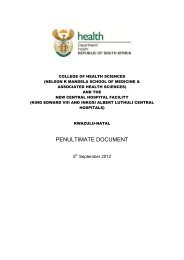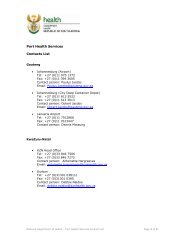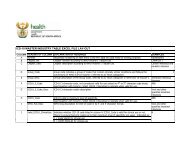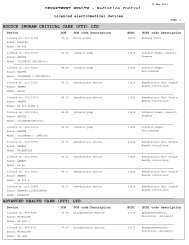National Norms and Standards relating to Environmental Health
National Norms and Standards relating to Environmental Health
National Norms and Standards relating to Environmental Health
Create successful ePaper yourself
Turn your PDF publications into a flip-book with our unique Google optimized e-Paper software.
7. PHOs should also develop <strong>and</strong> implement Water Quality Moni<strong>to</strong>ring Programmes for aircraft <strong>and</strong> portwater.8. WQMP should be implemented for compliance moni<strong>to</strong>ring <strong>and</strong> audit sampling purposes. The saidprogrammes should highlight the “objectives” for the sampling, location “where” <strong>to</strong> sample <strong>and</strong>assess the detemin<strong>and</strong>s “what” <strong>to</strong> be assessed, <strong>and</strong> the frequency “how often” <strong>to</strong> sample, for thepurpose of moni<strong>to</strong>ring of all water from catchment <strong>to</strong> consumer which has the potential <strong>to</strong> impacthuman health following use.9. PHOs should only conduct compliance moni<strong>to</strong>ring from pre-determined representative samplingpoints <strong>and</strong> at the user points as outlined in the WQMPs.10. PHOs should moni<strong>to</strong>r water supply, in accordance <strong>to</strong> deliberate water quality moni<strong>to</strong>ring programmesfor the purpose of quality assurance <strong>and</strong> <strong>to</strong> satisfy a quest <strong>to</strong> ensure optimum public health.11. PHOs should ensure that the WQMP is strictly followed <strong>and</strong> implemented; hence proper water qualitymoni<strong>to</strong>ring records should be kept at all times.12. PHOs should only use the SANAS 17025:2005 accredited labora<strong>to</strong>ries or Department of WaterAffairs (DWA)-approved labora<strong>to</strong>ries per method of analysis for analysis of samples, <strong>to</strong> ensurecredible results.13. Documentation for water quality moni<strong>to</strong>ring must be kept for assurance <strong>and</strong> analysis in the event ofan incident.14. Sampling must be done by Port <strong>Health</strong> Officials or other professionally trained personnel only.15. The water transfer points from the water source <strong>to</strong> onboard s<strong>to</strong>rage <strong>and</strong> distribution system shouldcomply with the WHO. Guide <strong>to</strong> sanitation <strong>and</strong> hygiene in aviation. 2011.16. Aircraft water systems should comply with the requirements as specified in the WHO. Guide <strong>to</strong>sanitation <strong>and</strong> hygiene in aviation. 2011.17. Port <strong>Health</strong> Officials should conduct compliance moni<strong>to</strong>ring <strong>and</strong> safety audits in the aircraft <strong>to</strong> ensurethat the persons on board the aircraft are provided safe water. A period necessary <strong>to</strong> determineappropriate corrective action <strong>and</strong> ensure that measured parameters have returned <strong>to</strong> safe levels.18. Surveillance of water supply in aviation must be accomplished by authorized <strong>and</strong> trained officers frompublic health authorities or qualified independent audi<strong>to</strong>rs <strong>and</strong> inspec<strong>to</strong>rs.19. The amount of water required for h<strong>and</strong> washing <strong>and</strong> other sanitation needs must be taken in<strong>to</strong>account in passenger aircraft designs;20. All water moni<strong>to</strong>ring/sampling should be well documented <strong>and</strong> records <strong>to</strong> be kept.STANDARDS FOR SHIPSSECTION 4: SHIPSAll ships must generally comply with the International <strong>Health</strong> Regulations, 2005 <strong>and</strong> relevant guidelines.Airline opera<strong>to</strong>rs must ensure that they inform passengers on health measures recommended by theWHO <strong>and</strong> adopted by South Africa. In addition, ship owners must keep their conveyances free fromsources of infection <strong>and</strong> or contamination including vec<strong>to</strong>rs. Ships should be subjected <strong>to</strong> ship sanitationinspection at the port. The ship must particularly comply with the following requirements:1. Structural facilitiesa) Design of ships must conform <strong>to</strong> international st<strong>and</strong>ards <strong>and</strong> recommendations2. Accommodation Establishmentsa) Accommodation establishments on board must conform <strong>to</strong> the specifications as per H<strong>and</strong>book forInspection of Ships <strong>and</strong> Issuance of Ship Sanitation Certificates;b) Adequate ventilation <strong>and</strong> heating systems must be provided;c) Sanitation facilities with h<strong>and</strong> washing <strong>and</strong> drying facilities must be provided in accommodationestablishments;d) All sanitation facilities must have adequate soap <strong>and</strong> <strong>to</strong>ilet paper;e) Bathrooms <strong>and</strong> showers must be provided;f) Accommodation establishments must be kept clean;g) Natural or artificial lighting must be provided.DOH. <strong>Norms</strong> <strong>and</strong> st<strong>and</strong>ards for environmental health in South Africa Feb 2013 84



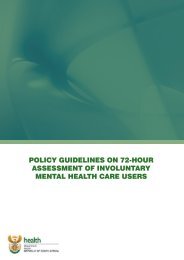
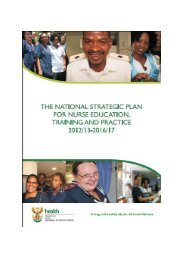
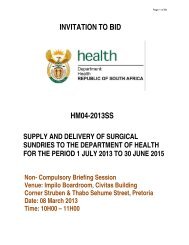
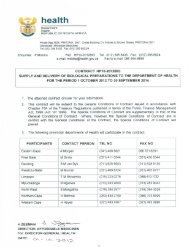
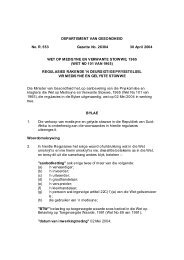
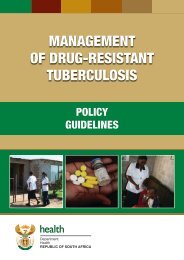
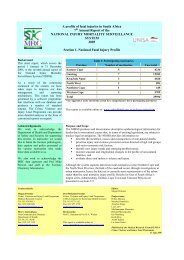
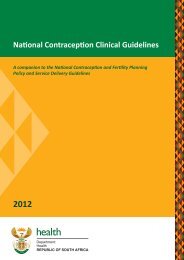
![A monograph of the management of postpartum haemorrhage [2011]](https://img.yumpu.com/15578784/1/184x260/a-monograph-of-the-management-of-postpartum-haemorrhage-2011.jpg?quality=85)
